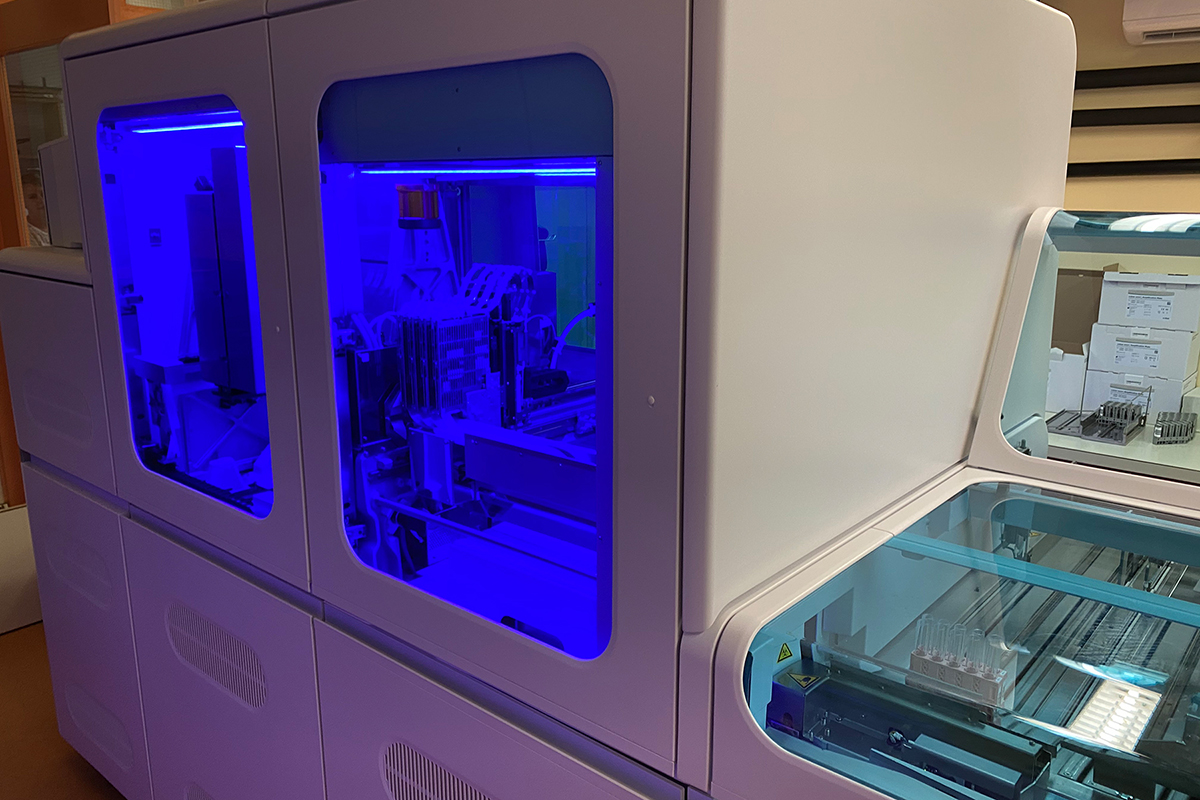Tests as an additional option for more safety
Daniel Candinas, Vice-Rector for Research and member of the coronavirus crisis management team, was able to draw on experience from his clinical environment when developing the University of Bern's testing strategy. Employees have been regularly tested there since the beginning of the pandemic.

Little is known about the best strategies in hospitals to protect healthcare workers. The study aims to find out which organizational measures can effectively contribute to protection. At the University Hospital for Visceral Surgery and Medicine we treat many vulnerable patients with autoimmune diseases or immunosuppression – for example after organ transplantation. To protect them, we began intensive employee testing twice a week in March 2020 as part of an SNF project. We are still carrying these out today.
We have carried out around 10,000 tests to date and have been able to identify a relevant number of asymptomatic, mostly younger employees as SARS-CoV-2 carriers, particularly before and during the first wave. In "calmer times" the rate of positive tests was zero for many weeks. By contrast, ten people tested positive in just one week at the peak in mid-November. Overall, the rate of positive tests was 0.4% over the past year, which is not surprising given the low pre-test probability.
You talk about pre-test probability – what do you mean by that?The pre-test probability tells us the likelihood of diseases being present before a test is carried out. If the pre-test probability is very low then you are looking for the famous needle in the haystack. It is not a precise instrument, but has to be determined on the basis of the circumstances according to criteria. With a greater pre-test probability, you are more likely to find a positive result with the given sensitivity of the test.
In the context of SARS-CoV-2 tests, there is a lot of talk about sensitivity, the sensitivity of the tests. Why?The sensitivity indicates the percentage at which infected individuals are actually detected by using a test. Therefore, the more sensitive a test is, the more reliably it detects infected people. High sensitivity is required above all in cases where a screening procedure is used to ensure that no infected person is missed. In the case of the common PCR tests for SARS-CoV2, the sensitivity is up to 98%, which is a very high value.
By contrast, specificity refers to the probability that healthy individuals who are not infected with the virus are actually identified as healthy or negative in the test. In a screening test that aims to detect as many people as possible who are affected by a particular disease, we accept a somewhat lower specificity as long as the sensitivity is as high as possible.
Does the precautionary testing of healthy or asymptomatic people actually make sense or does it rather give a false sense of security?Because SARS-CoV-2 is easily transmitted through social contact and symptoms vary greatly, testing is an essential part of tackling the pandemic. In this sense, testing is not a carte blanche for the individual but one component of an epidemiological concept for pandemic control and a prerequisite for detecting and interrupting chains of infection. Testing in no way replaces the usual protective measures. We cannot speak of "testing" as a general term either but must be very discriminating about the personal objective. It is important that attention is paid to high quality, methodologically correct and appropriate procedures and epidemiologically meaningful indications in all situations.
The university sees the use of saliva PCR testing as an additional way to increase the safety of students and lecturers at events that are allowed to take place with attendance due to the federal measures. However, they are not a measure to offer more attended events - which would not be allowed at the moment either.

Our testing strategy basically consists of 3 levels:
Level 1: Low-threshold individual testing: University members can be tested in the COVID-Track at Bern University Hospital.
Level 2: Repetitive testing at regularly scheduled events on a voluntary basis. This level is considered if events must take place on site (e.g. internships, courses, laboratory work). We prefer PCR tests as a method.
Level 3: Testing for multi-day field trips and on-site events that cannot be replaced by an alternative event format. This test level is mandatory for both the organizational unit and participants. We prefer PCR tests as a method.
Will it be possible to administer the exams on site in the summer by testing the students?The university crisis management team has reviewed the possibility that testing procedures could be used in combination with other measures in certain situations to ensure that more exams are administered with attendance. Logistical "rehearsals" were conducted for this to have the entire range of meaningful measures available in terms of quantity as well. The crisis management team carried out a risk-benefit assessment for each case to determine whether the expense of saliva PCR testing was justified.
However, due to the current pandemic developments, it is likely that examinations in the 2021 spring semester will have to take place in a similar fashion to the 2020 fall and spring semester, i.e. generally with online modalities; only a limited number of examinations, identified by the university management in collaboration with the faculties, will be allowed to be held with attendance.
University of Bern's testing strategy
About Daniel Candinas

Daniel Candinas has been full professor of surgery with a focus on visceral and transplantation surgery (surgery of the abdominal organs and internal glands) since 2002, director of the University Hospital for Visceral Surgery and Medicine at Bern University Hospital and Vice-Rector for Research since 2016. Until his appointment in Bern, he worked in Great Britain and at Harvard Medical School in Boston (USA). Candinas is involved in several associations and foundations on a part-time basis, for example as Vice-President of the Swisstransplant Foundation.
SNF project
SNF study: How can health workers be protected during an epidemic outbreak? Modeling a desynchronization strategy from the COVID-19 pandemic. This project will analyze the impact of the COVID-19 outbreak on the workforce of a large university hospital to understand how to best protect healthcare workers. Given that data are available from the university hospital for many professions outside the healthcare sector, some of the results may also be relevant outside the hospital. The study's PI is Prof. Guido Beldi, Associate Professor of Visceral Surgery at the University of Bern.
About the author
Nicola v. Greyerz works as an event manager in the Communication and Marketing Office of the University of Bern.